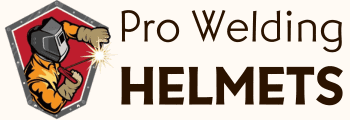Understanding the different types of welding helmets is crucial for anyone in our profession. With my extensive experience in fabrication, I’ve encountered various kinds of hoods, each serving SPECIFIC purposes and offering UNIQUE features.
From passive masks, which use a fixed shade lens, to auto-darkening helmets that adjust to the arc’s brightness (power), the range of options can be overwhelming. Each variety has its application for specific welding processes and environments, but not all hoods are suitable for every user.
In this guide, I’ll give you a detailed insight into different helmets for welding with their FEATURES, BEST USES, PROS, and CONS, helping you choose the right one for your needs.
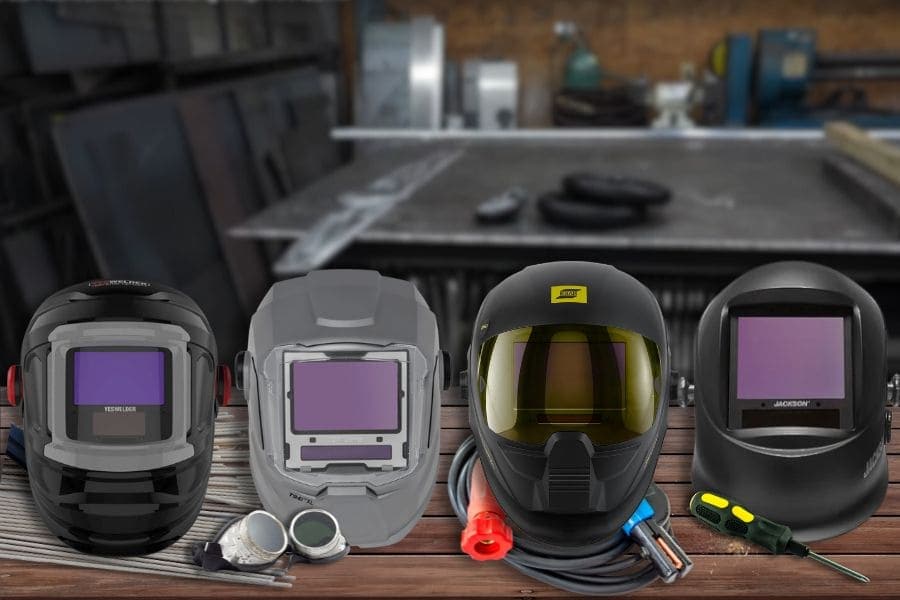
Welding Helmet Types Based On Uses
When you’re in the market for a new welding helmet, sorting them by their intended use can simplify your search. After all, whether a hood is suitable for your needs depends largely on your requirements.
1. TIG Welding Helmet
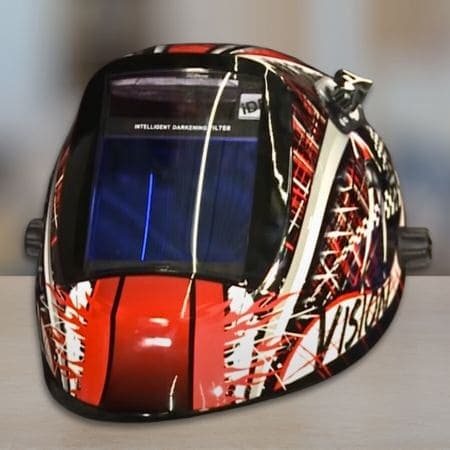
As a passive lens makes it too dark when TIG welding at low amperages, such as 50A, variable shade auto-darkening welding helmets are hands-down the ideal choice for TIG.
The standard darkness range for variable shade auto-darkening helmets is #9 to #13, which makes sense, considering it covers TIG, MIG, and stick welding at the same time.
The problem, however, is that these welding masks detect the amperage of the arc to ACTIVATE auto-darkening. In case the amperage is too low and doesn’t correspond with the lower end of the dark shade range, the hood won’t darken.
This is why low amp (10A to 25A) TIG welding requires you to use special variable auto-darkening helmets that come with an additional shade range of #5 to #9. So, depending on the ampere rating, you may either get a variable auto-darkening helmet with a #9 to #13 dark shade or one specifically made for low-amp welding.
2. MIG Welding Helmet
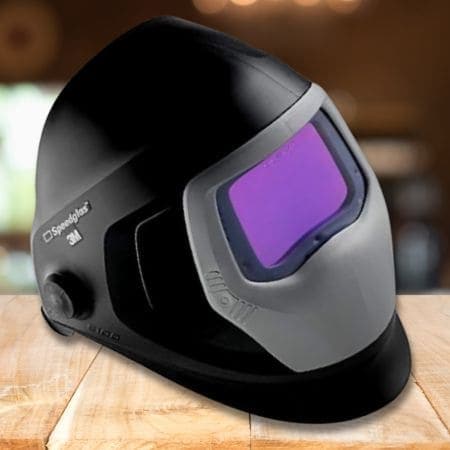
The arc of an MIG weld is significantly more powerful than that of a TIG weld, which calls for a HIGHER SHADE RANGE. Once again, a passive helmet wouldn’t be a good choice – this time because it might not be dark enough.
Even if you get a passive welding mask with a darker lens for your purpose, you’ll have to keep removing the hood repeatedly because it would be too dark to see anything when you aren’t welding.
Once again, a variable shade auto-darkening helmet is your best bet. The standard #9 to #13 lenses should suffice for MIG welding – just make sure that they are of good quality and meet all necessary safety standards.
3. Helmet With Cheater Lens
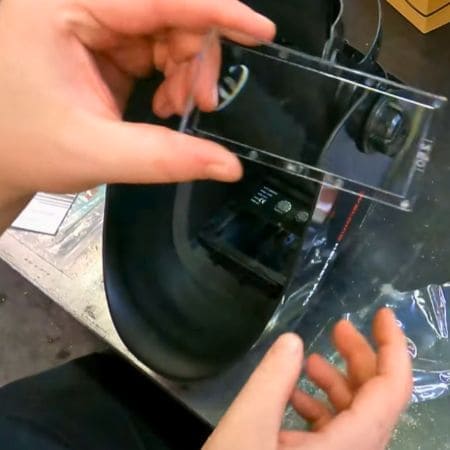
When it comes to precision welding, being able to see what you’re doing is crucial. Visibility can also pose an issue while fusing together small components.
Thankfully, now you don’t have to endanger yourself by bringing your face too close to the arc. Wondering why?
This is exactly why CHEATER LENSES exist – to magnify the view of your work. You could think of them as a welder’s version of reading glasses – standard lenses designed to improve visibility.
In case you already have a welding helmet, you can upgrade it by adding a compatible cheater lens. However, if you’re planning to buy a new one, why bother with all that hassle when you can simply get a hood with a cheater lens built-in by default?
You can get these styles of helmets at varying prices to suit your budget and requirements.
4. Smart Welding Helmet
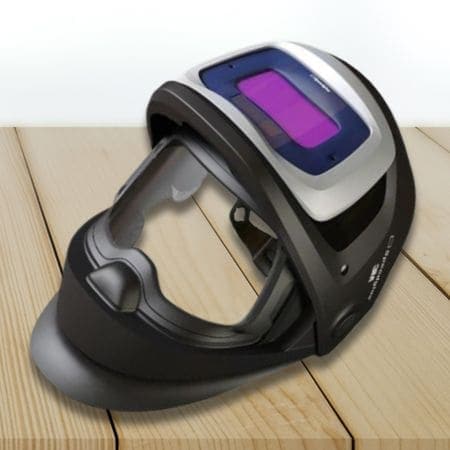
If you’re a tech geek, you might want to check out the latest additions to the market – SMART welding helmets equipped with digital features like Cameras and Bluetooth.
That’s right! You can now control stuff like lens settings using a mobile app connected to your helmet via Bluetooth.
I got myself a 3M Speedglas G5-01VC to check out what a Bluetooth-enabled welding hood is like, and it works like a charm. You can use your smartphone to perform a variety of tasks, like adjusting the shades and sensitivity settings, switching between pre-set memory modes, viewing your welding stats, and more.
These types of hoods are still relatively new, and you don’t have a lot of choices. One such smart welding headgear that grabbed my attention was the innovative Xtreme Dynamic Range (XDR) 3D weld visualization helmet.
Here’s why. Developed jointly by Japanese company Kawada Technologies, Inc. and American research center SRI International, it uses high-end cameras equipped with CMOS and IR sensors to improve visibility and perception for the welder.
5. Pancake Welding Helmet
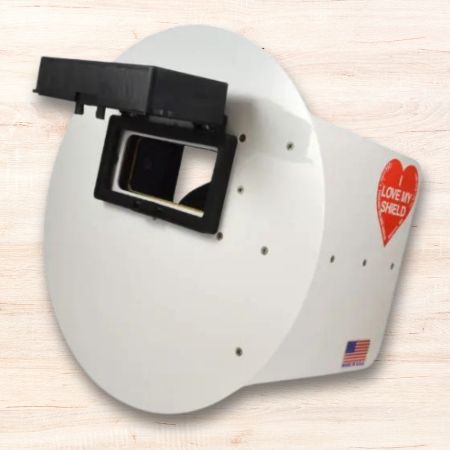
I know the name sounds funny, but a quick look at this FLAT and ROUND welding helmet will show you how it got the name in the first place. These unique PPEs are very different from traditional hoods in design because they serve a specialized purpose.
Typically used by pipeline welders, pancake welding masks have a balsa wood box on the inside that sits over the eyes and holds the lens. Since the front side is flat, one side of it is shielded to protect your face.
The balsa wood box can be easily sanded and shaped to fit the welder’s face perfectly, leaving no gap for unwanted light to enter and hamper visibility. It also keeps the lens from fogging up, thus helping maintain a CLEAR VISION.
Pancake helmets are very lightweight because they are made of balsa wood and thin metal, making them comfortable to wear. If your job involves working on pipelines for long hours, especially outdoors, getting yourself one of these helmets would be a great idea.
6. Respiratory Welding Helmet
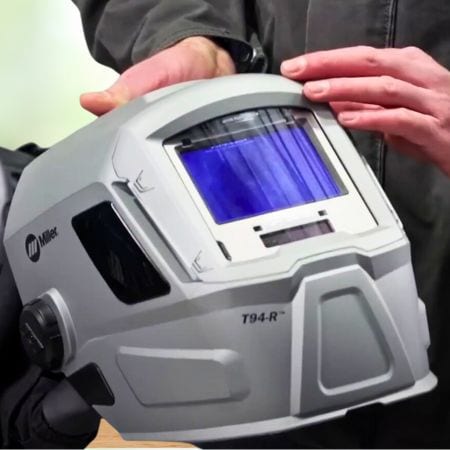
Respiratory welding helmets, also known as Powered Air Purifying Respirator (PAPR) masks, can go a long way in protecting your lungs while still allowing you to breathe properly.
Those are equipped with external blower units with changeable filters connected by a thick hose for sufficient airflow.
Not only are these powered respirators better at FILTERING out contaminants, but breathing is much easier, too. If you spend hours welding every day, I would highly recommend getting a PAPR helmet.
7. Underwater Welding Helmet
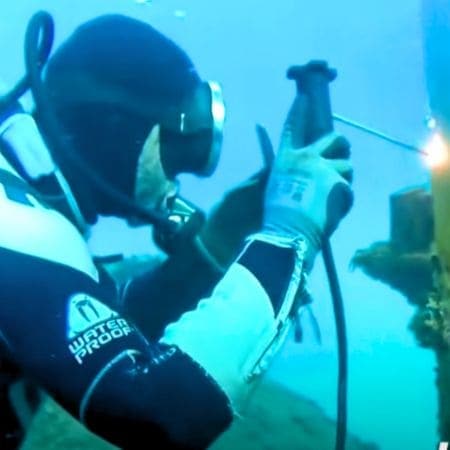
As the name suggests, these are specially designed welding helmets for underwater welding. In terms of design, they aren’t very different from the gear used by divers.
However, they have FLIP-UP lenses that you can pull down while welding to protect your eyes from intense flashes and harmful UV radiation.
Needless to say, these helmets are solely for underwater welders, such as those working at offshore oil and gas industries, structures, ships, submarines, etc. Their heavy weight makes them an impractical choice for regular use outside of water.
8. Multipurpose Welding Helmet
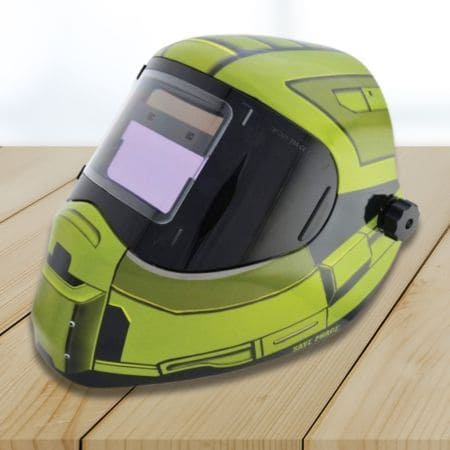
If you need a mask for more than just welding, consider getting a multipurpose one that also suits your other requirements. Some auto-darkening helmets come with a GRIND MODE. What is it important? You can use them for both welding and grinding.
Although grinding requires eye protection, too, it’s primarily to keep out sparks and metal debris. The glass needs to remain at a low shade to ensure proper visibility because, unlike while welding, there won’t be bright arc flashes.
A multipurpose welding helmet with a grind mode saves you the hassle of changing hoods as you SWITCH between welding and grinding. Considering you won’t have to buy a grinding eye protection separately, it’s also more cost-effective.
Types Of Welding Helmets Based On Lens Shade
One of the most crucial factors to consider when choosing a new helmet for welding is the type of lens it comes equipped with. You have three broad options in this regard:
A. Fixed Shade Or Passive Welding Helmet
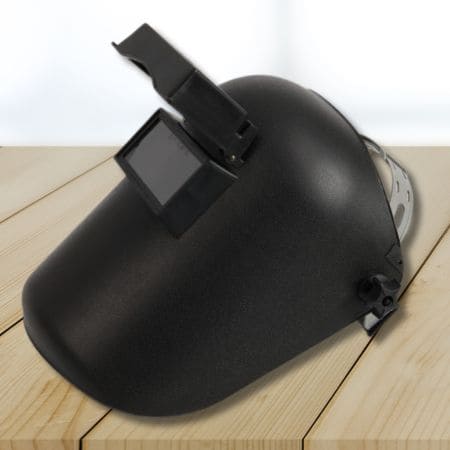
These welding helmets are the most basic in terms of lens shading. They feature a FIXED SHADE lens that remains dark at all times. Consequently, you would need to remove the mask to inspect a weld or get a clear view of something.
Typically, the lens is a shade number #10, but you can customize the hood by replacing the lens with one that better suits your needs.
Pros
Economical
Simple
Lightweight
Cons
Lack of versatility
Poor visibility when not welding
Fixed shade helmets are best suited for beginners with a tight budget or professionals practicing a specific welding task. Otherwise, consider the following alternatives.
B. Variable Shade Auto-darkening Welding Helmet
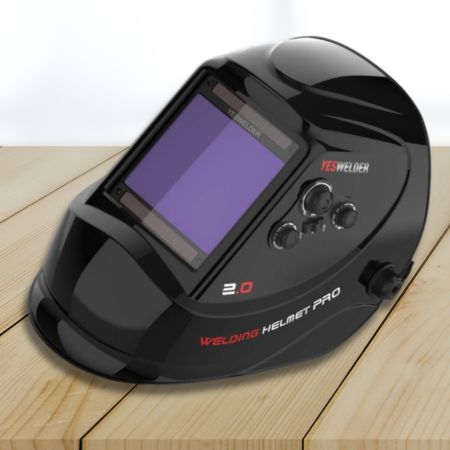
Allowing you to set the lens to the required shade based on the intensity of the arc, these are by far the best types of helmets in terms of lens shade. Auto-darkening welding helmets use liquid crystal cells and polarization filters to darken the lens to the desired shade.
Before you start welding, you can choose a dark shade corresponding to how much you need the lens to darken. When the arc sensors in the helmet detect a flash, they relay this data to an Electronic Control Unit (ECU), which in turn, controls the brightness level through the lens.
Now, when the helmet is in the off state, the default positioning of the polarization filters sets the hood to a PRE-SELECTED darkened shade. This is to protect your eyes in case the lens fails to activate.
Variable-shade auto-darkening welding masks are safer and fairly easy to use – you just have to set the appropriate shade level before you start working.
Pros
Convenient to use
Clear visibility
Flexibility to choose multiple shades
Cons
Expensive
Relatively heavy
If you’re looking to get the good stuff right away so that you don’t have to upgrade to a better hood soon, an auto-darkening helmet should be perfect. Unless you just need a hood for simple repairs and DIY fabrications once in a while, it is worth buying.
Also Read: Welding Helmet Shade Calculator
Helmet Styles Based On Face Coverage
With the purpose and lens type addressed, the next consideration is the style of face coverage the helmet provides.
Full-face Welding Helmet
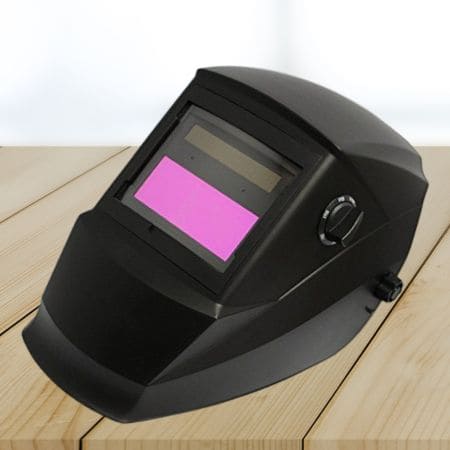
If you’re seeking comprehensive protection for your face and head while welding, it is undeniably the best choice. These hoods cover a large portion of your head, including your forehead, and the entirety of your face, including the sides of your chin.
In addition to shielding you from sparks, arc flashes, and debris from your own weld, they also protect you from anything that might come flying from other persons working nearby.
Full-face welding helmets are highly popular among welders and for good reason. I would recommend one unless you are on a tight budget and only need basic face protection for simple projects.
Half-mask Welding Helmet
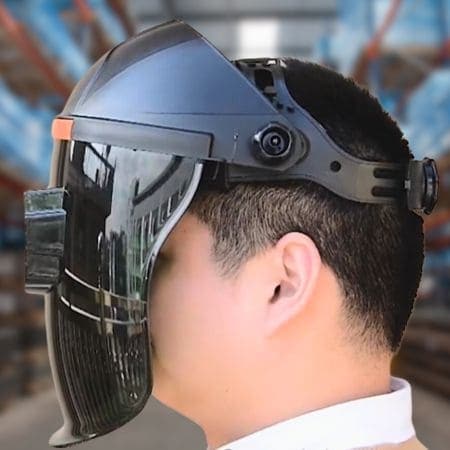
Half-mask welding helmets feature a GLASS VISOR that covers the entire front of your face.
Your head is partially or fully protected by the sturdy hat top on which the visor is mounted. While the sides of your face are left exposed, this is generally not a concern unless you are working in close proximity to other welders or grinders in a busy workshop.
While full-face hoods can be somewhat stuffy and uncomfortable for extended wear, these half-mask welding helmets offer a great alternative for working in less hazardous environments. I often use them myself for personal projects or when the workshop is less busy.
Flip-up Welding Helmet
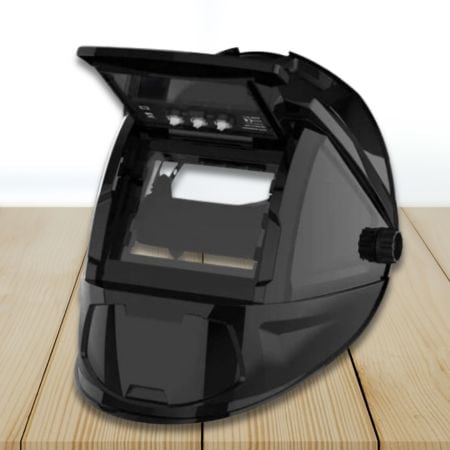
This old-fashioned face protection gear is basically a subtype of full-face welding helmets, with a distinct design. They derive their name from the flip-up mechanism of the lens. The lens holder is hinged to the helmet, allowing you to flip it up for a clear view when not welding and bring it down over your eyes when needed.
With auto-darkening helmets now widely available at various price points, flip-up hoods are not as popular as they once were.
However, they are still much more CONVENIENT than regular passive hoods, saving you the hassle of lifting them every time you need to inspect a weld. Underwater welding helmets often use flip-up lenses to allow welders to quickly switch between shaded and regular views.
While these hoods may not offer the same convenience as auto-darkening ones, requiring you to flip the lens up and down between welds, they represent a perfect middle ground between typical passive and auto-darkening helmets, especially if the latter is too expensive for you.
Safety Helmet With Welding Shield
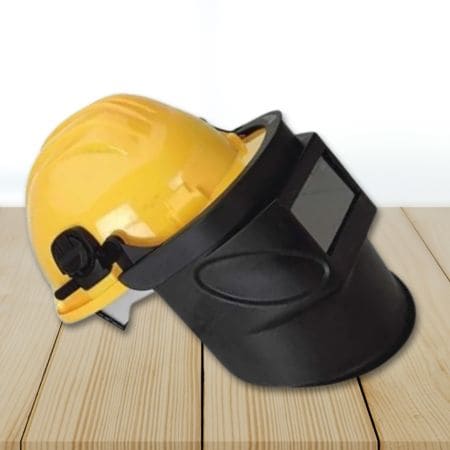
In addition to the protection provided by other headgear, these safety helmets also feature shields for impact resistance.
I personally used one of these while working as a welding engineer at a construction site where safety helmets were mandatory according to regulations.
While most welding and fabrication jobs do not require wearing protective headgear with a shield, these are particularly useful in industries such as construction, foundry work, mining, metallurgy, and others where protection from accidental impacts is essential for safety.
Types Depending On Power Supply To The Helmet
Back when I mentioned the electronic control unit while describing how auto-darkening helmets work, you must have figured out that they require some sort of a power source. But there’s more! Let’s check out the different varieties of welding masks based on power supply.
Battery-Powered
All auto-darkening helmets require a power source – typically coin batteries. Though not rechargeable, they are pretty cheap to replace. The battery powers up the sensors, the ECU, and the LC-cell filters and enables them to function.
Solar-Powered
Don’t get me wrong – you’ll still need batteries to operate a solar-powered welding helmet. However, the difference is that these hoods don’t rely entirely on batteries. Another misconception is that a solar-powered headgear requires direct sunlight.
The battery initially powers up the helmet, allowing you to begin welding. Once the arc is initiated, solar panels integrated into the gear start generating power by absorbing UV rays from the arc.
This not only harnesses otherwise harmful UV rays but also means you don’t necessarily have to work outdoors when using a solar-powered helmet.
Manual/ Non-powered Helmets
These are simple passive lens welding helmets that have no need for a power supply. All you have to do is bring the hood down on your face, and you’re good to go. While they are pretty safe and easy to use, they come with all the downsides of passive lenses that I mentioned earlier.
Welding Helmet Varieties Based On Material
Moving on, let’s check out the different welding helmet materials that you get to choose from while buying your gear.
ABS Plastic Helmet
These are essentially among the cheapest and most lightweight welding helmets, but don’t let that fool you. Made from high-quality ABS plastic, they are quite sturdy and durable. ABS is a poor thermal conductor, which makes hoods made of this material perfect for typical arc welding.
Pros
Lightweight
Economical
Low thermal conductivity
Excellent rigidity
Shock-absorbant
Cons
Not as durable or chemical resistant as other materials
Leather Welding Hood
Leather is one of the oldest welding helmet materials, still used for its flexibility and excellent resistance to heat and fire. While I would categorize them as hoods or masks rather than helmets, modern leather headgear comes with similar features as helmets made of other materials, such as auto-darkening lenses and flappable panels.
Pros
Great insulation
Flexible
Excellent protection against fumes, gases, and debris
Cons
Uncomfortable in hot and humid weather
Fiberglass Welding Helmet
Fiberglass is a great alternative to ABS with its excellent insulating capabilities. Compared to ABS, which usually carries a matte finish, fiberglass hoods have a glossy look. The material is SHAPE-RETAINING, offers high tensile strength and does a great job absorbing vibrations.
Fiberglass also works great as a sound insulator, thus keeping out the loud welding noises. Its negligible moisture absorption makes fiberglass welding helmets good for working in humid environments.
Pros
Excellent tensile strength
Great sound insulation
Reduced vibrations
Fire retardant
Cons
Not as rigid as the ABS
Nylon-based Helmet
Among synthetic materials, this is another economical option among welders. While nylon isn’t as strong as ABS, it is much more durable – which means your helmet would last longer unless damaged by HEAVY IMPACT. Nylon is also more resistant to chemicals, which might be something to consider depending on the industry.
Pros
High durability
High resistance to chemicals
Cons
Poor strength and stiffness
Polycarbonate Welding Helmet
Both ABS and fiberglass are great, but polycarbonate offers the best of both worlds. Like ABS, it is highly impact-resistant and is actually the stronger material of the two. Like fiberglass, polycarbonate hoods don’t absorb much moisture.
It can also withstand high temperatures without sustaining any damage. Besides, a lot of welding helmets use POLYCARBONATE LENSES for their superb optical clarity and damage resistance.
Pros
Extremely durable
High impact resistance
Fares well against heat and humidity
Lightweight
Cons
Relatively expensive
Carbon-Fiber Welding Helmet
Carbon fiber is a premium material known for its exceptional strength-to-weight ratio. Helmets made from carbon fiber are lightweight yet incredibly strong, providing excellent protection without the bulk.
The material’s high tensile strength makes it resistant to impacts and vibrations, offering superior durability. Additionally, carbon fiber masks are highly resistant to heat, making them ideal for welding applications where heat resistance is crucial.
Pros
Exceptionally lightweight
Incredibly strong and durable
High resistance to heat
Superior impact resistance
Cons
Higher cost compared to other materials
Kinds Of Welding Helmets According To The Number Of Sensors
If you’re purchasing an auto-darkening hood, it’s crucial to consider the number of arc sensors it includes. The more sensors your helmet has, the better coverage it provides, ensuring your eyes are protected from flashes caused by out-of-position welds.
- Two Sensor Hoods: These are typically found in hobby-grade helmets, offering sufficient coverage for welding flashes directly in front of you. They are suitable for small DIY projects and repairs.
- Three Sensor Helmets: A professional-grade welding hood should have at least three arc sensors. These are suitable for production work and fabrications where out-of-position flashes are not expected.
- Four Sensor Helmets: I always recommend that everyone in my workshop wears a helmet with at least four sensors. These are ideal for most fabrication and out-of-position welding tasks, providing protection against flashes from other welders nearby.
While some high-end welding helmets come with five or six arc sensors, they are often unnecessary for most welders. However, if it fits within your budget, opting for a headgear with a couple of extra sensors certainly won’t hurt.
How To Tell What Type Of Welding Helmet You Have?
To determine the category of your welding helmet, start by checking its specifications and details on the box, manual, or any documentation provided by the manufacturer. If you received the hood without these documents, you can still identify its lens:
- Put on the helmet and assess how clearly you can see without welding. If the view is very dark (usually shade #10), it is passive.
- If the view is only slightly darkened (shade #3), your helmet is auto-darkening.
- Look for shade adjustment settings. If you can select your preferred shade, it’s a variable shade auto-darkening helmet. If not, it’s a fixed shade hood.
Identifying other aspects like power source, face coverage, and material should be straightforward. With a clear understanding of all categories of welding helmets, a simple inspection should reveal the one you have.
Selecting the Right Welding Helmet for You
So, with such a vast variety of welding helmets to choose from, how do you know what’s most suitable for you? Well, here’s what I personally do – I start narrowing down my options based on the following criteria, ultimately picking a hood that ticks all the boxes.
Welding Application
First and foremost, it’s crucial to consider YOUR INTENDED PURPOSE behind using the hood. As I explained earlier, different welding processes require different helmets. Getting an MIG helmet would be a waste of money if you’re planning to use it for low-amp TIG welding.
Consider factors like the lens type, lens shade/shade range, and amperage to shortlist helmets that would suit the purpose. For special applications and working environments, also consider specialized welding masks like PAPR and pancake helmets.
Light State And Shade of Helmet
I know I just mentioned the shade range, but this crucial factor deserves a special mention of its own. When exploring auto-darkening helmets, check out both the light and dark state shade numbers.
For the former, a lighter state offers better visibility. As for the dark shade, it must correspond with the amperage of your weld. While an insufficiently dark lens won’t offer you enough protection, an excessively dark one would hinder your visibility.
Lens Reaction Time
Auto-darkening welding lenses activate in a fraction of a second from the moment their sensors pick up the weld flash. However, there are still differences, with higher-end welding helmets offering a much faster lens reaction time than cheap ones. The quicker the lens turns dark, the more EFFECTIVELY it protects your eyes.
Sensors, Their Sensitivity, And Delay Settings
Of course, the sensors go hand-in-hand with lens reaction time. While it’s always better to get a helmet with more sensors, you’d also have to balance cost with performance. There’s no need to get one with more than 3 sensors for simple welding projects and DIY repairs. Instead, invest in a hood with superb sensitivity for immediate and accurate flash detection.
Professionals might want to get a welding helmet with delay settings, which essentially allows you to set a delay period during which the lens will stay dark even after you stop welding. This feature is very handy for large fabrication projects where you might need a few moments to reposition for the next weld.
True Color And Optical Clarity
Visibility is a clear factor to consider when narrowing down your options. Unless the lens offers sufficient optical clarity, you’d have a hard time seeing what you’re doing while you weld. Due to the way welding lenses work to filter out harmful UV and IR rays, everything around you would typically be in a shade of low-contrast green when you wear a welding helmet.
However, some brands have come up with modern masks that feature TRUE COLOR technology, which changes the view to a higher contrast that incorporates the rest of the color spectrum.
Viewing Area
While we are talking about visibility, let’s not forget the size of the viewing area. Some helmets only have a relatively small rectangular lens over the eyes, while others have a much larger viewing area.
For example, in half-mask hoods, you get to see through most of the front part. A larger viewing area enlarges your field of view, which might be helpful in certain welding and fabrication projects.
Face Coverage
Considering the whole purpose of a welding helmet is to protect your face and eyes, let’s not forget face coverage. While I’d usually recommend a full-face hood, other designs with smaller coverage might be fine, depending on your requirements.
Depending on the industry and safety requirements, you may also consider getting a safety helmet with a welding shield.
ADF Power Requirements
If you’re getting an auto-darkening mask, would you rather choose a solar-powered hood or a battery-operated one? While the former comes with a higher price tag, it can save you money on batteries in the long run.
Material And Durability
Generally speaking, most of the welding helmet materials I mentioned earlier are pretty durable and can be used in most environments. Consider criteria such as comfort, cost, durability, insulations, and specific characteristics to choose a hood that offers the best value for money.
Among these, durability is a particularly important factor as your chances of needing a new helmet anytime soon depend on it.
Special Features
With the basics covered, you can now look for special features like Bluetooth connectivity and a Camera. These aren’t absolutely necessary for most projects, but you may consider getting a welding helmet with such features for specialized welding work or simply for the sake of convenience.
Comfort And Fit
Now that your options are down to a select few, put on the different helmets and compatible accessories to see which ones fit the best and make you most comfortable. Remember, even small elements that influence your comfort can make a huge difference when welding for extended periods.
Price
Lastly, consider the price of the masks to pick one that suits your budget and offers good value for money. You can easily find a welding hood for under $50 and up to $1000, depending on the features and build material.
Investing in a top-notch hood is always worth it, considering it’s a matter of safety. However, if you are a hobbyist or simply want to carry out small repairs, there’s no need to spend on an expensive professional-grade welding helmet.
Key Takeaways
Welders rely on different types of helmets, each tailored to specific needs and offering unique features. Passive masks use a fixed shade lens, while auto-darkening hoods adjust to the arc’s brightness, providing a range of options for various welding processes and environments.
TIG welding demands variable shade auto-darkening helmets for low amperages, whereas MIG welding requires a higher shade range for the more powerful arc.
For PRECISE welding, cheater lenses offer magnification, while smart helmets incorporate digital features like cameras and Bluetooth connectivity for enhanced functionality.
Pancake hoods, with their flat and round design, are favored by pipeline welders for their lightweight comfort and specialized features.
RESPIRATORY masks, equipped with external blower units and changeable filters, ensure proper airflow and lung protection during welding.
Underwater welding helmets, resembling diving gear, have flip-up lenses for eye protection against flashes and harmful UV radiation.
MULTIPURPOSE hoods with grind modes offer the flexibility to switch between welding and grinding tasks seamlessly.
While FIXED SHADE helmets are budget-friendly, they lack versatility compared to variable shade auto-darkening helmets, which offer clear visibility and flexibility.
Full-face welding helmets provide extensive coverage, while half-mask helmets offer a lighter option for less hazardous environments.
FLIP-UP hoods offer a convenient middle ground between passive and auto-darkening helmets, allowing for quick adjustments.
Safety helmets with welding shields offer additional impact resistance, making them ideal for industries where safety is paramount.
Welding helmets can be powered by batteries or solar energy, or be manual/non-powered, each with its advantages and considerations.
ABS plastic, leather, fiberglass, nylon, polycarbonate, and carbon fiber are materials commonly used in hoods, each with its strengths and durability.
Welding masks can feature two, three, four, or more arc sensors, with additional sensors providing better coverage and protection.
